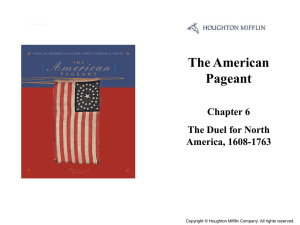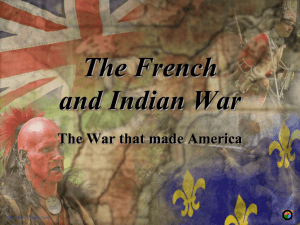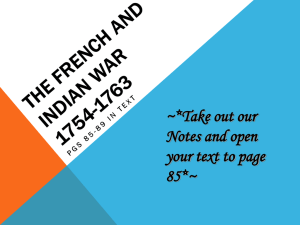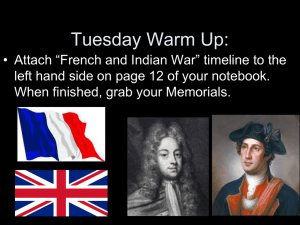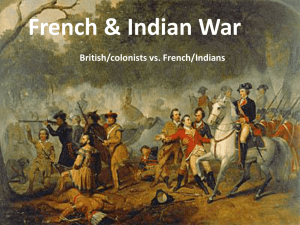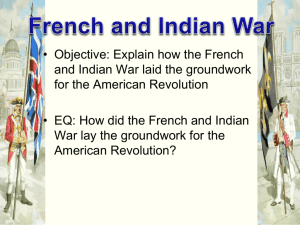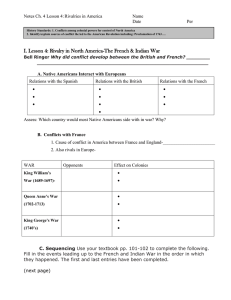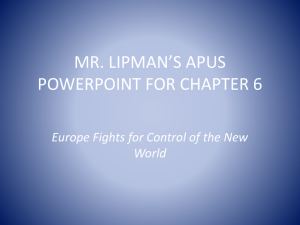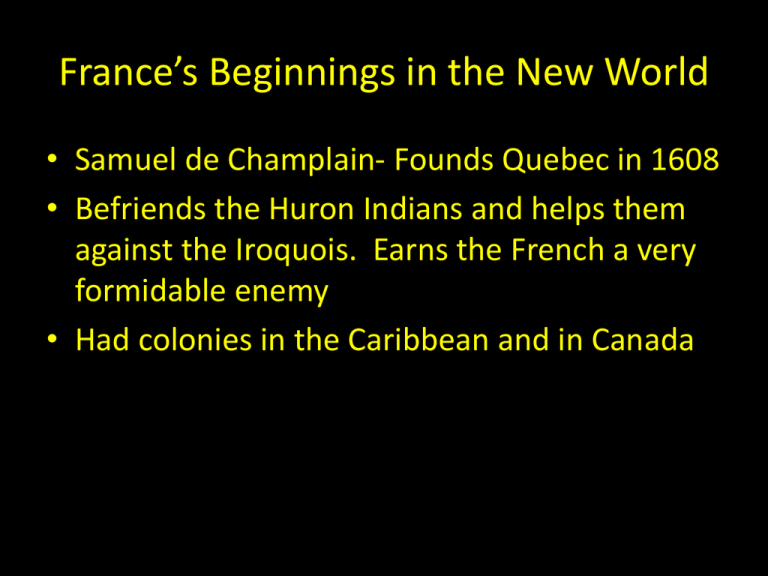
France’s Beginnings in the New World
• Samuel de Champlain- Founds Quebec in 1608
• Befriends the Huron Indians and helps them
against the Iroquois. Earns the French a very
formidable enemy
• Had colonies in the Caribbean and in Canada
Spread of French Influence
• French fur-trappers (coureurs de bois) spread out
across the continent (Terre Haute, Baton Rouge,
Des Moines)
• Spread of the fur trade takes the French across
the Great Lakes, into Central and Western
Canada, and into the Great Plains from Missouri
and Arkansas to the Rockies
• Jesuit missionaries tried to convert Native
Americans to Catholicism, but mostly failed.
Exploring and map-making were two of their
most important roles
Other French Explorations
• Antoine Cadillac (1701)- founder of Detroit
• Robert de La Salle (1682)- goes down the
Mississippi River to its mouth at the Gulf of
Mexico. Names the land Louisiana in honor of
Louis XIV
• Found New Orleans in 1718.
• Allows the French to send grain from Illinois
down the Mississippi for export
Map 6.1: France's American
Empire at Its Greatest Extent,
1700
Copyright © by Houghton Mifflin Company. All rights reserved.
4
Early Wars
• King William’s War (1689-1697) and Queen
Anne’s War (1702-1713)
– British colonists against French coureurs de bois
– Guerrilla warfare tactics
– Native Americans ally with the French to harass British
settlements on the frontier
– Spanish ally with France to harass South Carolina
settlements
– Treaty of Utrecht ends the wars
• England gets Nova Scotia, Newfounland, and the Hudson Bay
area
Map 6.3: British Territory
After Two Wars, 1713
Copyright © by Houghton Mifflin Company. All rights reserved.
6
Important legacy of the Treaty of
Utrecht
• 40 years of peace between the British and
French
• During this period, the British pretty much
ignore the colonies (“salutary neglect”)
• British win some trading rights in Spanish
America, but this causes problems with
smuggling and leads to the War of Jenkins’s
Ear
King George’s War
• War of Jenkins’s Ear merges with the War of
Austrian succession in Europe to form King
George’s War in the Americas (1740-1748)
• France allies with Spain…again.
• New Englanders invade into New France…again.
– They capture the French fort of Louisbourg,
overlooking the St. Lawrence River
• Peace treaty in 1748 gives the fort back to the
French, the New Englanders are beyond mad
Conflict with the French…Again
• Competition between the French and British
over the Ohio Valley
• Group of Virginians lay claim to 500,000 acres
in the upper Ohio Valley (Western PA and
Eastern OH
• The French had already begun building forts
along the Allegheny and Ohio Rivers, most
notably Fort Duquesne
George Washington comes on the
scene
• George Washington sent with 150 militiamen to
secure the huge claim of land
• Virginians open fire on a small group of French
troops and kill their leader
• French attack Washington’s troops at Fort Necessity
and force him to surrender.
• The Seven Years War (French and Indian War) had
begun.
• The British forces the Acadians in Nova Scotia to
leave. Cajuns in Louisiana
French and Indian War
• Major war in Europe causes the French to not be
able to send enough troops to fight in the Americas
• Prior to this, the Americans had shown a lack of unity
in wars
• 1754- Albany Congress
– Immediate purpose is to keep the Iroquois loyal to
the British
– Long-term purpose is to achieve a higher level of
colonial unity for the defense against France
(Franklin’s cartoon)
The F and I War in America
• Starts off badly for the colonists
• The British General Braddock loses at Fort Duquesne
in 1755. Easy victory for the French and Indians
• The whole frontier from Pennsylvania to North
Carolina was now open to Indian attack
• Washington tries to defend the frontier with only 300
men
• The British invade Canada in 1756. Should have
attacked Quebec and Montreal, but they don’t so
defeat after defeat occur
Map 6.6: Events of 1755–1760
Copyright © by Houghton Mifflin Company. All rights reserved.
13
The influence of William Pitt
• Makes the decision for the British to concentrate on the
Quebec/Montreal portion of Canada
• Louisbourg falls (again) in 1758
• Quebec falls in 1759
• Montreal falls in 1760, and the French are finished in Canada
• Treaty of Paris 1763 ends the war, and the French are thrown
off the North American continent
• France cedes all of Louisiana territory to Spain
• Florida given to England by Spain in return for Cuba
• Great Britain is now the dominant power in North America
and the dominant naval power in the world
The Impact on the Colonists
• More confident in their military strength
• Myth of British invincibility shattered
• Tension and conflict between the British
officers and the colonial militias
• The colonists didn’t support the cause
wholeheartedly. Shippers traded with the
Spanish and the French West Indies during the
war
• Americans had to be bribed to defend the
colonies against the French and Indians
More Impact
• Intercolonial disunity continues
• BUT, some of the barriers are beginning to be
broken down when colonial soldiers and
statesmen meet during the war at various
times and see all they have in common
Aftermath of the War
• Spanish, French, and Indians much less of a
threat
• Chief Pontiac of the Ottawa led a group of
tribes to try and drive the British out of Ohio
Country
– Detroit under siege in 1763
– All but three British posts west of the
Appalachians are taken
– British react by distributing smallpox infected
blankets among the Natives
Map 6.8: North America
After 1763 (after French
losses)
Copyright © by Houghton Mifflin Company. All rights reserved.
18
Proclamation of 1763
• British station troops west of the Appalachian
Mountains
• Colonists begin to move West
• The Proclamation of 1763 bans settlement in
the area west of the Appalachians
• Angers Americans
– View that Americans had fought in the war and
deserved to expand West
Map 6.9: Settled Areas at
End of French and Indian
War, 1763
Copyright © by Houghton Mifflin Company. All rights reserved.
20


